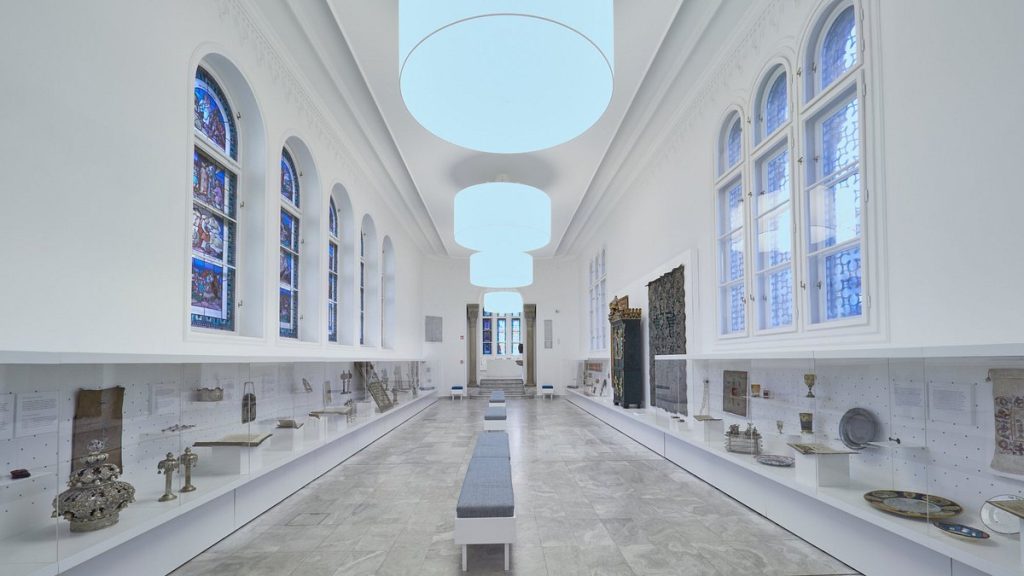Hungarian Jewish Museum and Archives: Preserving Budapest’s Jewish Heritage
Step into the rich tapestry of Budapest’s Jewish history at the Hungarian Jewish Museum and Archives, a repository of culture, tradition, and resilience. Located in the heart of Budapest, this museum safeguards and showcases Hungary’s rich Jewish heritage. Among its collection are unique treasures such as the world’s oldest pair of Rimónim and a 3rd-century tombstone.
Founding and Early History
Establishment and Initial Exhibition
The Hungarian Jewish Museum was officially founded on December 1, 1909, when the Israelite Hungarian Literary Association decided to establish it. Its first exhibition opened in 1916 at Hold Street 23, displaying nearly 1,500 Jewish ceremonial objects and historical relics. The creation of this museum was part of a broader movement across Europe, with similar institutions emerging in cities like Vienna (1895) and Prague (1906).
The 1930s and The New Building
By 1932, a new museum building was completed next to the Dohány Street Synagogue. Designed in a style that complemented the main synagogue building, the new permanent exhibition opened its doors on December 26, providing a dedicated space to celebrate and preserve Jewish history and culture.
Impact of Anti-Jewish Measures and Wartime Challenges
Anti-Jewish Policies and Emancipation Exhibition
The anti-Jewish policies of the 1930s and 1950s hindered the museum’s progress. Despite these challenges, the museum held the “Emancipation Exhibition” in 1938, showcasing the circumstances of the 1867 emancipation law and the assimilation process of Hungarian Jews. This exhibition highlighted the resilience and cultural contributions of the Jewish community during a time of increasing oppression.
Preservation Efforts During the War
During the wartime years between 1939 and 1944, the museum housed OMIKE’s annual art exhibitions, providing a platform for Jewish artists excluded from other forums due to anti-Jewish laws. In 1940, museum staff organized collection tours to gather memories of disappearing rural Jewish communities. To protect its valuable collection from wartime threats, in 1942, part of the museum’s collection was placed in the cellar of the Hungarian National Museum. Unfortunately, more valuable items intended for preservation in bank vaults disappeared during the war.
Post-War Period and Renewed Commitment
Post-Liberation Efforts
After the liberation in 1945, the museum surveyed the tangible heritage of the destroyed rural communities, synagogues, and cemeteries. The museum reopened its doors to visitors on July 4, 1947. In 1960, a comprehensive exhibition titled “From Slavery to Freedom” opened, detailing the Holocaust and the history of Jewish liberation. A new permanent exhibition was launched in 1984 to commemorate the 40th anniversary of the deportations in Hungary.
Establishment of the Archives
In 1972, the Hungarian Jewish Archives were opened in the National Rabbinical Institute. By 1994, the archives and the museum were combined, resulting in the institution being officially named the Hungarian Jewish Museum and Archives. This merger allowed for a more comprehensive preservation and presentation of Jewish heritage in Hungary.
Recent Developments and Current Exhibits
Restoration and New Permanent Exhibition
In 2016, the museum building underwent comprehensive restoration. A new permanent exhibition titled “Tamid” (meaning “always” or “constantly” in Hebrew) was set up. This exhibition showcases Jewish relics and significant works by Hungarian painters of Jewish origin, such as Imre Ámos, Adolf Fényes, Izsák Perlmutter, and Izsó Köves. Holocaust memorabilia were moved to a separate museum, allowing “Tamid” to focus on the broader spectrum of Jewish life and culture.
Theft and Recovery
Tragically, in 1993, almost all the museum’s exhibited material was stolen, only to be found in Romania the following summer. This incident underscored the ongoing challenges in preserving cultural heritage and highlighted the museum staff’s resilience and dedication in recovering and restoring their invaluable collection.
Visiting the Hungarian Jewish Museum and Archives
Location and Accessibility
The Hungarian Jewish Museum and Archives is centrally located in Budapest, adjacent to the Dohány Street Synagogue. It is easily accessible by public transport or on foot, allowing visitors to conveniently include it in their exploration of Budapest’s rich cultural landscape.
Exhibits and Educational Programs
Visitors can explore a wide range of exhibits that delve into the religious, cultural, and social history of Hungarian Jews. The museum offers educational programs, guided tours, and special events that provide deeper insights into the exhibits and the broader context of Jewish heritage in Hungary.
Significance and Legacy
The Hungarian Jewish Museum and Archives isn’t just a museum; it’s a tribute to a community’s enduring spirit. Whether tracing the footsteps of history, deepening your understanding of cultural diversity, or simply seeking a meaningful connection, this museum invites you to honor and appreciate Budapest’s Jewish heritage. It stands as a testament to the resilience, creativity, and contributions of Hungarian Jews throughout history.


